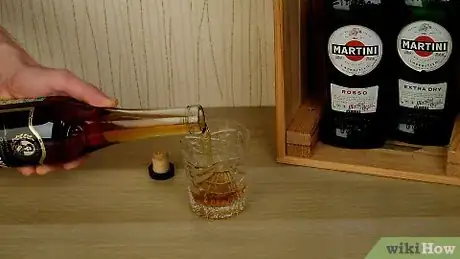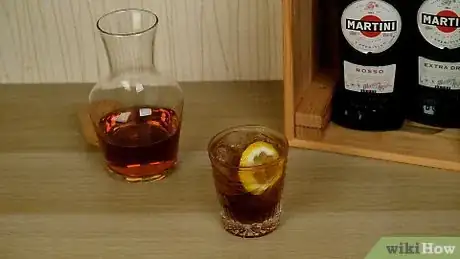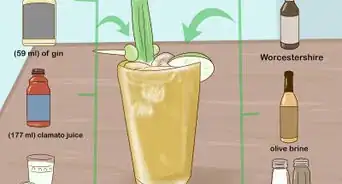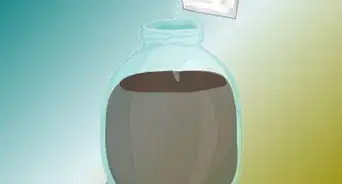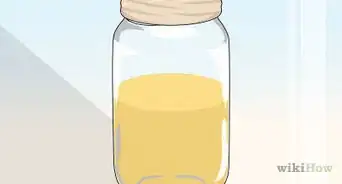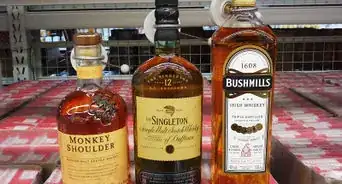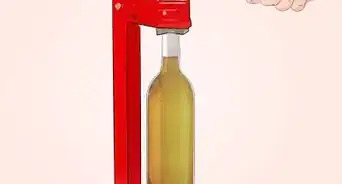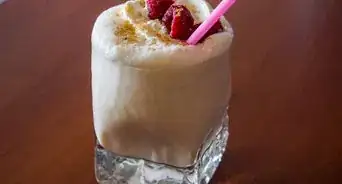This article was co-authored by wikiHow staff writer, Eric McClure. Eric McClure is an editing fellow at wikiHow where he has been editing, researching, and creating content since 2019. A former educator and poet, his work has appeared in Carcinogenic Poetry, Shot Glass Journal, Prairie Margins, and The Rusty Nail. His digital chapbook, The Internet, was also published in TL;DR Magazine. He was the winner of the Paul Carroll award for outstanding achievement in creative writing in 2014, and he was a featured reader at the Poetry Foundation’s Open Door Reading Series in 2015. Eric holds a BA in English from the University of Illinois at Chicago, and an MEd in secondary education from DePaul University.
The wikiHow Culinary Team also followed the article's instructions and verified that they work.
This article has been viewed 13,794 times.
Learn more...
Nothing hits the spot quite like a smooth glass of brandy after a long day. Unfortunately, if you aren’t a frequent drinker, you may not have any plans on finishing the bottle any time soon. Brandy technically has an infinite shelf life, but the ingredients will start to deteriorate in quality after roughly 6 months, so try your best to polish that bottle off within a few months after opening it. If anything, a nice bottle of opened brandy is just a good excuse to invite a few friends over and enjoy some drinks!
Steps
Keeping the Brandy in the Bottle
-
1Close the top securely with the cap or wine stopper. Take the original cap and put it back in the top of the bottle. If your bottle came with a cork, grab a wine stopper and insert it into the mouth of the bottle. Keep in mind, you can’t reuse a cork since corks degrade over time. They can also develop nasty odors and bacteria after a bottle has been opened.[1]
- There’s nothing wrong with storing your brandy in its original bottle, especially if you have a fancy bottle and you want to show off the label.
-
2Set the brandy in a dry location away from direct sunlight. If you have a liquor cabinet, set your brandy inside along with your other bottles. Alternatively, you can set the brandy in a pantry, on top of your fridge, or in the basement. Aim for an area where the temperature remains stable and there isn’t a lot of direct sunlight.[2]
- It helps if the brandy stays a little on the cooler side, but the temperature won’t impact the brandy all that much so long as your home doesn’t get 80 °F (27 °C) or hotter.
- You don’t typically refrigerate brandy, but you can if you’d like!
Advertisement -
3Keep the bottle upright to keep the brandy off of the cap or wine stopper. Traditionally, brandy is stored upright to keep the brandy from brushing against the cork, which can disrupt the flavor of the liquor before it’s opened. It’s best to store your opened brandy upright for the same reason: to keep the cap or wine stopper from changing the brandy’s flavor.[3]
- Storing your brandy upright also decreases the odds that you end up with a spill on your hands if the bottle isn’t completely sealed.
-
4Drink your brandy within 6 months for best results. Brandy doesn’t technically go bad, but the quality of the liquor will begin to deteriorate after 6 months have passed. If you can, finish your bottle within the next few months to preserve the flavors and get the most out of your brandy.[4]
- You can write the date you opened the bottle on the brandy’s label if you think you may cut it close to that 6-month threshold.
- The amount of air in your bottle may have a small impact on the quality of the brandy over time. If you only have a few fingers of brandy left in the bottle, try to finish it within the next 2-3 months if you really care about the flavor. You may not notice a huge impact if you drink it after 4-5 months, though.
Using a Decanter
-
1Select a cool decanter to display your brandy with style. If you have a nice decanter, this is the best way to display your brandy if you want a more aesthetically-pleasing presentation. Take your decanter out of storage or take it off of your bar and set it out on your countertop. Wash your decanter out and let it air dry if you haven’t used it or cleaned it in a while.[5]
- A decanter is designed to help open up wine by exposing it to a small amount of oxygen. This process doesn’t do anything for brandy. The only reason to use a decanter is if you don’t like random bottles sitting out around your home.
- If you have a cheaper bottle of brandy, a nice decanter is a great way to present your brandy without tipping others off that you’re drinking the cheap stuff.
-
2Pour the brandy into the decanter carefully and close the top. Open the top of your decanter and remove the top of your brandy. Hold the neck of your brandy against the rim of the decanter’s mouth. Slowly and carefully tilt the bottle up and pour your brandy into the decanter. Empty your bottle out and discard it. Then, put the cap on your decanter and check the seal around the cap to make sure the bottle is airtight.[6]
- If your brandy came in a dark bottle, set a small light down next to the decanter before pouring your brandy. This will make it much easier to see the neck of the bottle as you pour.
- You can use a clean funnel to make pouring easier if you’d like.
-
3Set the decanter on your bar or in a visible location to show it off. Choose a prominent, highly-visible location to show off your decanter. The bar is the traditional option, but a liquor cart, or a small table is great choice as well. If you can, keep the decanter out of direct sunlight to keep the quality as high as possible.[7]
-
4Drink your brandy in the next 4-6 months for ideal taste. Brandy will start to deteriorate after 6 months, and the decanter has a small chance of letting some air into your liquor. In addition, a decanter won’t keep light from disrupting the ingredients the way a dark bottle will. Keeping this in mind, your brandy may start to turn a little faster than it normally would in the original bottle. Try to finish your brandy within 4 months to enjoy it while it’s still good.[8]
- Your brandy may still be perfectly fine if you don’t get to it in 4 months. You may not notice much of a difference anyway. You will almost certainly taste the difference if you wait more than 6 months, though.
- A small amount of brandy may deteriorate a little faster than a nearly-full decanter. If your decanter isn’t particularly full, try to finish the brandy in the next 2-3 months.
Determining If Brandy Is Still Good
-
1Toss your brandy after 1 year if you want a decent-tasting drink. An opened bottle of brandy will be pretty hard to drink after 1 year has passed, so you’re better off pouring it down the drain if you’d prefer to not drink soured brandy. It isn’t dangerous to drink old brandy if it has been opened, but the odds are low that you’ll get much enjoyment out of it.[9]
- The high alcohol content of brandy keeps it from developing bacteria or mold, but oxidation can break down some of the ingredients and damage the flavor. Once the brandy is exposed to air, the ingredients essentially start turning. This takes a long time to happen, but the oxygen will eventually ruin any non-alcoholic ingredients in your liquor.
-
2Assume the brandy is still good if it’s been less than 6 months. If it hasn’t been more than 6 months and you weren’t storing the brandy in the sun or in an unopened container, your brandy is almost certainly going to be tasty even if it doesn’t taste brand new. You can skip all of the guessing, smelling, and inspection and jump right to the drinking if you haven’t had the bottle for more than 6 months.[10]
-
3Smell the brandy to assess the aroma if it’s been 6-12 months. Appraising whether a brandy has soured or gone flat is largely a guessing game, but you can generally tell if the brandy is good or not just by smelling it. Open the top and take a sniff of the liquor. If it smells smooth, fruity, spirited, and sweet, you’re good to go. If you smell anything else, your brandy may have started to deteriorate.[11]
- Brandy is made out of distilled wine, but there may be a variety of other ingredients and fruits added to your specific brandy. There is no iconic brandy “smell” the way there is for gin, vodka, and bourbon, so you may have to trust your gut a little.
-
4Taste a small sip to see if the flavor is pleasant as a final test. If you still aren’t sure if the brandy is good or not, a taste test is in order. Pour 1–2 teaspoons (4.9–9.9 mL) of your brandy into a glass and take a small sip. If the brandy tastes fine to you, it’s time to enjoy! If it tastes terrible, just pour it out. If it doesn’t taste phenomenal but it still feels drinkable, some mixed drinks may be in order.[12]
-
5Mix the brandy into some cocktails if it’s a little off but still fine. If you’re on the fence about drinking your brandy and pouring it, you can mask the flavor of the slightly-off brandy with some additional ingredients. Brandy is a great base for a brandy Manhattan, sidecar, Pisco Sour, or Jack Rose. You can also mix the brandy with some coke, lemonade, or sweet tea for a simpler option.[13]
- This is probably your best bet if the brandy isn’t in pristine condition but you know you’ll feel guilty about pouring an expensive bottle down the drain. Mixers and cocktail ingredients should mask some of the more questionable notes in the brandy.
References
- ↑ https://www.stilltasty.com/fooditems/index/16610
- ↑ https://www.stilltasty.com/fooditems/index/16610
- ↑ https://www.thrillist.com/how-to/how-to-store-scotch
- ↑ https://www.doesitgobad.com/does-brandy-go-bad/
- ↑ https://vinepair.com/wine-blog/do-i-really-need-to-decant-my-whiskey/
- ↑ https://www.winespectator.com/articles/how-to-serve-wine-decanting
- ↑ https://vinepair.com/wine-blog/do-i-really-need-to-decant-my-whiskey/
- ↑ https://www.doesitgobad.com/does-brandy-go-bad/
- ↑ https://www.doesitgobad.com/does-brandy-go-bad/


